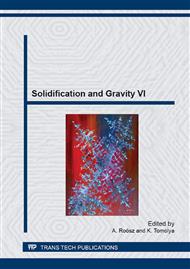[1]
T.E. Quested, Understanding mechanisms of grain refinement of aluminium alloys by inoculation, Mater. Sci. Tech., 20 (2004) 1357-1369.
DOI: 10.1179/026708304225022359
Google Scholar
[2]
A.M. Bunn, P. Schumacher, M.A. Kearns, C.B. Boothroyd, A.L. Greer, Grain refinement by Al-Ti-B alloys in aluminium melts: A study of the mechanisms of poisoning by zirconium, Mater. Sci. Tech., 15 (1999) 1115-1123.
DOI: 10.1179/026708399101505158
Google Scholar
[3]
P.S. Mohanty, J.E. Gruzleski, Mechanism of Grain-Refinement in Aluminum, Acta. Metall. Mater, 43 (1995) 2001-(2012).
Google Scholar
[4]
P. Schumacher, A.L. Greer, J. Worth, P.V. Evans, M.A. Kearns, P. Fisher, A.H. Green, New studies of nucleation mechanisms in aluminium alloys: Implications for grain refinement practice, Mater. Sci. Tech., 14 (1998) 394-404.
DOI: 10.1179/mst.1998.14.5.394
Google Scholar
[5]
M. Easton, D. StJohn, Grain refinement of aluminum alloys: Part II. Confirmation of, and a mechanism for, the solute paradigm, Metall. Mater. Trans. A: Physical Metallurgy and Materials Science, 30 (1999) 1625-1633.
DOI: 10.1007/s11661-999-0099-4
Google Scholar
[6]
G.P. Jones, J. Pearson, Factors affecting the grain-refinement of aluminum using titanium and boron additives, Metallurgical Transactions B, 7 (1976) 223-234.
DOI: 10.1007/bf02654921
Google Scholar
[7]
J.A. Spittle, S. Sadli, Effect of alloy variables on grain refinement of binary aluminium alloys with Al-Ti-B, Mater. Sci. T, 11 (1995) 533-537.
DOI: 10.1179/mst.1995.11.6.533
Google Scholar
[8]
M. Easton, D. St John, the effect of alloy content on the grain refinement of aluminium alloys, light metal, 2001, pp.927-933.
Google Scholar
[9]
C.A. Tarshis, J.L. Walker, J.W. Rutter, Metall. Trans, 2(1971) 2589.
Google Scholar
[10]
I. Maxwell, A. Hellawell, A simple model for grain refinement during solidification, Acta Metall, 23 (1975) 229-237.
DOI: 10.1016/0001-6160(75)90188-1
Google Scholar
[11]
P. Desnain, Y. Fautrelle, J.L. Meyer, J.P. Riquet, F. Durand, Prediction of equiaxed grain density in multicomponent alloys, stirred electromagnetically, Acta. Metall. Mater, 38 (1990) 1513-1523.
DOI: 10.1016/0956-7151(90)90119-2
Google Scholar
[12]
M. Easton, D. St John, An analysis of the relationship between grain size, solute content, and the potency and number density of nucleant particles, Metall. Mater. Trans. A: Physical Metallurgy and Materials Science, 36 (2005) 1911-(1920).
DOI: 10.1007/s11661-005-0054-y
Google Scholar
[13]
Z. Fan, Epitaxial Nucleation and Grain Refinement, Proceedings of the John Hunt International Symposium, UK, 2011, pp.29-44.
Google Scholar
[14]
Z. Fan, An Epitaxial Model for Heterogeneous Nucleation on Potent Substrates, Metall. Mater. Trans A, 44 (2012) 1409-1418.
DOI: 10.1007/s11661-012-1495-8
Google Scholar
[15]
Standard test procedure for alumnium grain reifners: TP-1. The alumnium association, Washington, DC, (1987).
Google Scholar


